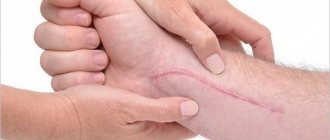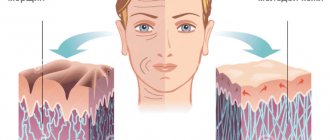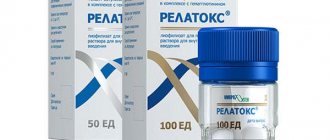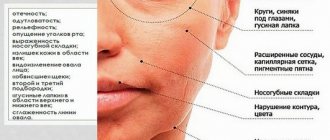Dear friends, hello!
Today we’ll talk about scars and the products that pharmacies have to make them less noticeable.
First things first, let me remind you that skin has three layers. The topmost layer is the epidermis, followed by the dermis and subcutaneous fat.
If we accidentally scratch ourselves somewhere, the topmost layer, the epidermis, will be damaged. And since it consists of horny scales, which gradually rise from its lower layers to the upper ones and peel off, the scratch will heal very quickly and without visible consequences. There will be no scar left.
But in our lives, even more serious injuries occur, when a deeper layer, the dermis, is damaged: a wound, a cut, a burn, a puncture, an operation. In some of these situations, you have to see a doctor and get stitches; in others, the skin damage heals on its own.
But in both cases, a scar is formed.
What is a scar?
This is the same connective tissue that forms the basis of the dermis, only formed in an emergency, which means it is rougher and less elastic.
Since this is connective tissue, it means that it contains fibroblast cells that synthesize collagen and hyaluronic acid.
As in healthy connective tissue, there are enzymes collagenase and hyaluronidase. They break down old molecules of collagen and hyaluronic acid to make room for young ones, since their lifespan is limited.
New blood vessels are formed in the area of damage to deliver nutrients here for speedy recovery.
Immune cells are drawn to the wound site. They trigger an inflammatory response. This is necessary to protect the damaged area from healthy tissue.
In general, the work here is in full swing. Outwardly, this is noticeable by swelling around the suture or wound, redness, and discharge of ichor.
As a result, a scar forms. A scar is a seal. A kind of patch to restore the integrity of the fabric.
Unfortunately, this “patch” will not go away on its own. The dermis cannot “shed” cells like the epidermis does.
The mechanism of complex action of Fermenkol
Fermenkol has a complex effect on the main components of scar tissue and can be used as monotherapy.4
Fermenkol exhibits selective activity towards pathological collagen, undergoes deep and complete hydrolysis of the peptide bonds of excess collagen in scar tissue, and also ensures deep hydrolysis of hyaluronic acid in the excess extracellular matrix.
As a result of the effect of Fermenkol on dehydrated scar tissue, its hydration (moistening) parameters approach those characteristic of healthy skin.9
Thanks to the complex effects of Fermenkol, the anti-scar effect is achieved in the shortest possible time .
Stages of scar formation
The scar does not form immediately, but in three stages:
Stage 1. Inflammation and epithelization. It lasts 7-10 days after the injury. It is important here that the wound does not fester, is treated correctly, so that its edges do not diverge. All this greatly influences the future appearance of the scar.
Stage 2. Formation of a young scar (10-30 days after injury). Collagen fibers begin to form at the site of injury. The scar is bright red, because it is abundantly supplied with blood, which delivers nutrients here.
Stage 3. Formation of a mature scar (up to 1 year). The number of vessels decreases, the scar becomes stronger and paler. Collagen fibers line up in a specific pattern along lines of greatest tension to protect the problem area.
What conclusions follow from all of the above?
- A scar is inherently “defective” connective tissue, rougher and less elastic. Its basis is the protein collagen and hyaluronic acid, which are sometimes formed here in excess. Therefore, it is logical to act on the scar with means that break them down (proteolytic enzymes, hyaluronidase).
- The use of external agents should begin approximately 2-3 weeks after injury/surgery, when a scar has already formed. They are not applied to fresh damage.
- The appearance of the scar largely depends on proper care of the wound and prevention of its suppuration/dehiscence.
How Fermenkol works -
The active components of Fermenkol have high activity in reducing the rate of collagen production in the skin. As you know, scar tissue forms due to increased levels of collagen production. Keloid and hypertrophic scars are formed as a result of an unexplained failure in collagen production - when collagen is produced in excessive, excessive quantities.
Collagenase, which is part of Fermenkol products, selectively acts only on the molecules of pathological collagen contained in the scar tissue of atrophic and keloid scars, destroying them, resulting in a reduction in the scar. According to the manufacturer: Fermenkol has virtually no effect on normal collagen of healthy skin tissue.
Thus, with the help of a complex of enzymes, collagen and elastin fibers are hydrolyzed, which break down into individual amino acids. Enzymes also hydrolyze polysaccharides in scar tissue, such as hyaluronic acid.
Important : Fermenkol only acts on scars that are no more than 1-2 years old, when scar tissue formation is still active.
Technologies that ensure the effectiveness of Fermenkol –
- Firstly, the manufacturer uses collagenolytic proteases with a molecular weight of only 23,000 to 36,000 Daltons, which ensures good penetration of enzymes deep into scar tissue.
- Secondly, Fermenkol contains components that increase the permeability of the stratum corneum of the skin by increasing its hydration (moistening), and also increase the permeability of the dermis due to the swelling and loosening of interstitial collagen and elastin.
- It is also known that scar tissue has very little hydration (moistening) with water when compared to normal skin tissue. A normal level of hydration provides healthy skin with turgor, elasticity, a youthful and healthy appearance. Fermenkol provides not only the hydrolysis of pathological collagen, but also deep hydration of scar tissue, which together ensures a reduction in scars, as well as an improvement in their appearance.
What types of scars are there?
There are 4 types of scars:
Normotrophic - flush with the surface of the skin - the most “correct” and pretty. The scar completely fills the skin defect without deforming its surface.
Atrophic is “minus” skin. Looks like a depression. Such scars form after acne and chickenpox. If there are a lot of them, the skin gives the impression of being lumpy.
Hypertrophic – “plus” skin, i.e. rises above its surface. This scar is usually red or even bluish in color. The amount of collagen in this scar is excessive. It looks unaesthetic.
A keloid scar, or keloid, is the most unfavorable outcome of skin damage. It looks terrible. It rises above the level of the skin, is red-bluish in color, goes beyond the boundaries of the damage, spreads to healthy areas, and due to this takes on bizarre shapes. The amount of collagen is off the charts, and its formation proceeds faster than the destruction of old protein molecules.
The worst thing is that over the years it continues to grow.
Externally it resembles a tumor. At a certain moment it may stabilize, and then, due to some impact, it again begins to creep apart.
And it’s not a fact that surgeons will help in such a situation. A keloid scar is an unpredictable thing. No one can predict how he will behave after surgical excision.
In addition to the aesthetic side, itching, pain, and tingling are felt at the site of the keloid scar.
Why do hypertrophic and keloid scars form?
There are several reasons:
- Prolonged healing due to concomitant diseases, age, and metabolic characteristics.
- Supuration of the suture.
- Failure to observe a rest regime for the injured area (incorrectly selected exercises, ignoring the wearing of a postoperative bandage, etc.). And someone, not having time to recover after surgery, runs to the gym to quickly get back in shape. This cannot be done. You need to wait at least 3 months. Or maybe more.
- Permanent injury to the scar by clothing (belt, girdle, collar, etc.).
- Individual characteristics.
- Doctor errors during surgery or in the postoperative period.
How are hypertrophic and keloid scars usually treated?
- Corticosteroids are injected into the keloid scar to reduce inflammation, itching, pain, swelling, and redness.
- Enzyme preparations based on collagenase and hyaluronidase are injected into the scar. They break down excess collagen, reduce scar density, and restore skin elasticity. IN ADDITION, the doctor may prescribe an external agent based on proteolytic enzymes and hyaluronidase to continue treatment, care for the scar and consolidate the effect.
- Physiotherapy is prescribed (laser resurfacing, exposure to cold - cryodestruction, phonophoresis with the same enzymes, etc.).
- Scar tissue is excised. This is rarely done, because... The keloid may then recur.
And now, in light of what I said, let’s analyze and compare with each other some popular external remedies for scars that are in your assortment.
Fermenkol: price, release forms
You can buy Fermenkol in any pharmacy without a doctor's prescription, however, the cost of the drug in different pharmacies varies greatly.
- Fermenkol gel (Fig. 4) – the active substance is a 0.01% complex of proteolytic enzymes, more precisely collagenolytic collagenases (proteases). Auxiliary components: glycerin, ammonium sulfate, methylisothiazolinone, acrylate crosspolymer and water.
→ Fermencol gel price (tube 30 g) – from 1100 to 1500 rubles, → Fermencol gel price (tube 10 g) – from 700 to 900 rubles. - Fermenkol set (for electrophoresis at home) – the set contains 2 bottles – see Fig. 5. The first contains a yellowish powder, which contains a complex of proteolytic proteases (4 mg). The second bottle contains Solactin, a solvent for preparing a 40 ml enzyme solution, which includes: water, potassium hydroxide, calcium chloride, citric acid and methylisothiazolinone.
Solactin (compared to saline solution) promotes more efficient penetration of enzymes into the depths of scar tissue. Moreover, using different amounts of solvent to dilute the powder, you can obtain different concentrations of the active components. The manufacturer recommends using a solution concentration of 0.01-0.02% for hypertrophic scars, and 0.05-0.1% for keloid scars.
The prepared solution is used for administration using the electrophoresis method. The latter can be easily carried out at home if you purchase an electrophoresis device intended for home use, for example, “Elfor” (about 3,000 rubles).
Summary:
Of all the products we reviewed, I liked Fermenkol the most, because... it acts on the rumen pathogenetically, and its mechanism of action is clear to me.
But I would put Contractubex in last place. I was not convinced by its composition.
In addition, due to onion extract, it can cause skin irritation. Why does the poor scar need additional problems?
For atrophic scars (for example, after acne), contrary to the assurances of the manufacturers, in my opinion, all of the above remedies will be ineffective, because atrophic scars, as I have already said, are “minus” tissue.
Here, cosmetic procedures will most likely help: dermabrasion, mesotherapy, laser peeling, etc.
Fermenkol Gel – instructions for use
Fermenkol Gel is available in tubes of 10 or 30 g and has a transparent consistency. The gel must be used within one month after opening the tube. There are 2 ways to use Fermenkol gel: firstly, by application, and secondly, using the phonophoresis technique.
Important : the gel can only be used 3-4 weeks after the wound has completely healed. We also repeat that the drug only acts on scars whose age does not exceed 1-2 years!
Application application –
This technique is more suitable for fresh, immature scars that are not yet dense enough so that medicinal components in the composition of products for external use cannot penetrate into them.
- First, thoroughly wash the area of application with water and a mild cleanser.
- After this, dry your skin well.
- Next, apply a small amount of Fermenkol gel to the skin in the scar area using light circular movements. Let the gel dry.
- It is necessary to repeat the procedure 2-3 times a day for 30-40 days. Then a break of 10-14 days is taken. After this period, the course can be repeated.
Using the phonophoresis technique -
The phonophoresis technique involves the combined effect of some means for external use and a device that produces ultrasonic waves. As a last resort, the manufacturer recommends using the Reton device, which can be easily used at home.
Ultrasound used in phonophoresis –
- promotes loosening of collagen fibers,
- increases the penetration of enzymes deep into the rumen,
- enhances the action of proteolytic enzymes.
Important : this technique is preferable for patients with old mature scars. Such scars are very dense, which makes it difficult for the usual penetration of medicinal components from products for external use (24stoma.ru). Under no circumstances should phonophoresis be used on fresh young scars, because ultrasound at this stage of scar formation can, on the contrary, stimulate the production of pathological collagen.
Methodology for carrying out phonophoresis with Fermenkol gel - phonophoresis procedures must be performed every day. The permissible interval between procedures is no more than 2 days. One course is 10-15 procedures, after which you should take a break of 10-14 days. After a break, the course can be repeated.
- First, thoroughly rinse and dry the skin around the scar.
- After this, for better penetration of the active components of the gel, it is additionally recommended to apply a hot, but not scalding, cloth to the scar area for 5 minutes.
- Next, apply a sufficient amount of gel to the skin of the scar.
- Carry out the phonophoresis procedure: firmly attach the head of the ultrasound machine, without allowing the gel to be squeezed out. Move the head of the device over the problem area slowly, effortlessly in forward circular movements. Do not remove the emitter head from the skin during the entire procedure. Make sure that Fermenkol gel does not dry out (add gel if necessary).
The duration of the procedure for one area is → for children over 3 years old – no more than 2-3 minutes, → for adults – no more than 5 minutes.
The radiation intensity of the device for phonophoresis is → for the area of the torso and limbs – 0.3 W/cm2. → for the face and neck area – 0.2 W/cm2.











